From the Library of Congress to Oxfordâs Bodleian Library, the British Library to the Vatican Library, there is no shortage of famous beautiful libraries around the world.
Others may not be as well known, but theyâre still a sight to behold. Any book lover would dream to spend a few hours perusing their bookshelves, soaking in their history.
Grab your library card and join ±«Óătv Bitesize as we take a trip around the globe and wander between the book stacks.
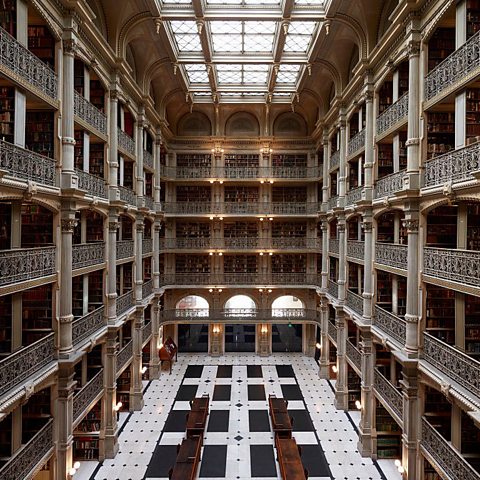
George Peabody Library, Baltimore, USA
With its striking black and white marble floor, ornamental cast-iron balconies and huge skylight, itâs no surprise that the George Peabody Library has been called a âCathedral of Booksâ.
Named after the man who funded it, American philanthropist George Peabody, the library formed part of a wider cultural centre called the Peabody Institute, which was one of the first ââAn educational institution which specialises in music training and research. in the US. It opened in 1878 and since 1982 has been connected to the John Hopkins University, but remains open to the public.
The libraryâs 300,000 volumes generally date from the 19th Century, but cover a wide variety of topics, including religion, science, history and geography.
You might recognise the large atrium from the rom-com Sleepless in Seattle. When Annie (Meg Ryanâs character) visits her brother at his office, she stops outside of, and walks through, the George Peabody Library.

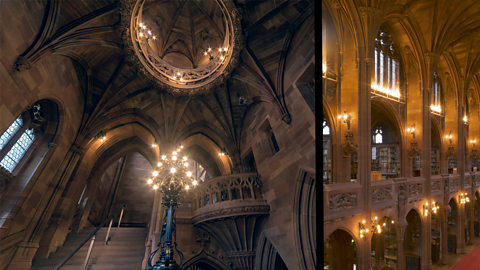
John Rylands Library, Manchester, UK
Walking through the John Rylands Library, youâd be forgiven for thinking that it was actually a cathedral, thanks to its neo-Gothic architecture, including vaulted ceilings, alcoves and stained glass windows. The architect was Basil Champneys, who also designed numerous libraries at the University of Oxford and the University of Cambridge.
While the John Rylands Library is named after a wealthy Manchester merchant, it was actually founded after his death (1888) by his Cuban-born wife, Enriqueta Rylands. She was the major beneficiary of an estate worth ÂŁ2,574,922 (ÂŁ280,345,298 today) so had the money to buy large collections of books and manuscripts from aristocratic families.
The inauguration ceremony took place on 6 October 1899, Enriqueta and Johnâs wedding anniversary. On the same day, Enriqueta became the first woman to be awarded the honorary Freedom of the City of Manchester.
Take a closer look at the stonework and stained glass and youâll notice the use of the Lancashire red rose (the county where John was born) and the coat of arms of St Helens (his hometown).
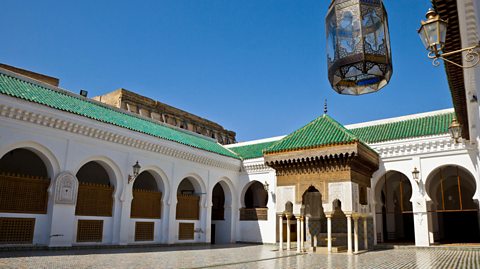
Al-Qarawiyyin Library, Fez, Morocco
Another library founded by a woman is the al-Qarawiyyin Library in Fez, Morocco. Itâs part of the University of al-Qarawiyyin, which was originally founded as a mosque in 859, by Fatima al-Fihri, the daughter of a wealthy merchant. Little is known about Fatimaâs early years, only that she was born in Qayrawan, Tunisia, after which the mosque was named.
One of the oldest libraries in continuous use, it was closed off to the public for hundreds of years, open only to scholars. However, following decades of rainwater infiltrating the building, the Al-Qarawiyyin Library underwent renovations and was officially re-opened with public access in 2017. To prevent further water damage and improve drainage, architect Aziza Chaouni included an underground canal system as part of her design.
Other additions included a lab for treating, preserving and digitising texts and a secure, temperature and humidity controlled room. Historically, the most valuable works were located in the manuscript room, kept safe by a door which had four locks and required four different keys owned by separate people to open.

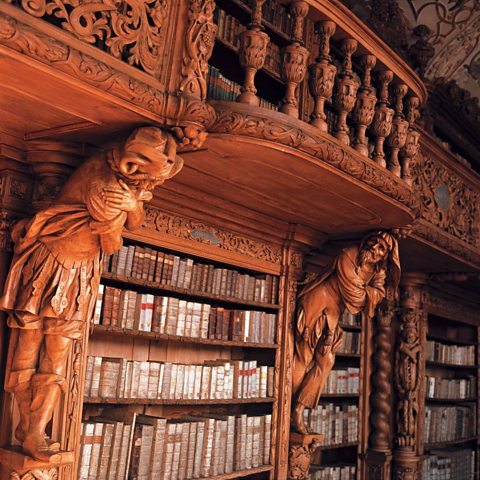
Waldsassen Abbey Library, Bavaria, Germany
Religious learning was also the driving force behind the creation of a library at Bavariaâs Waldsassen Abbey.
The abbey itself was founded in 1133 by members of the male Cistercian order but was sold in 1803 and became a cotton factory.
In 1863 it was bought back by Cistercian nuns, who opened both a nunnery and girlsâ school on the site.
The library was built during the 1720s and is notable for its intricate wood carvings.
The upper level of the library is supported by a series of columns, carved into the shapes of human figures who appear to be straining to hold up the balcony on their shoulders. These figures are said to represent vices such as vanity and ignorance.

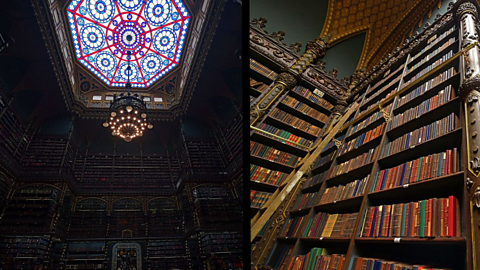
Royal Portuguese Cabinet of Reading, Rio de Janeiro, Brazil
Rio de Janeiro is home to the largest collection of Portuguese language books outside of Portugal, found inside the aptly named Royal Portuguese Cabinet of Reading. Brazil declared its independence from Portugal in 1822, but Portuguese remains its official language. Several years after independence, a group of 43 Portuguese immigrants decided to create a literary hub for their community.
When work on the library began in 1880, it marked three hundred years since the death of the great Portuguese poet LuĂs de CamĂ”es. The library is located on a street named after him. The exterior of the building was inspired by the 16th Century JerĂłnimos Monastery in Lisbon, Portugal, where the poetâs tomb can be found. A first edition of his most famous work, the epic poem Os LusĂadas (The Lusiads), is one of the libraryâs greatest treasures.
The Royal Portuguese Cabinet of Reading significance to Portuguese culture was recognised by Portugalâs decision to award it legal deposit status, ensuring that the Brazilian library receives a copy of every published piece of Portuguese literature. This is about 6,000 new books every year.
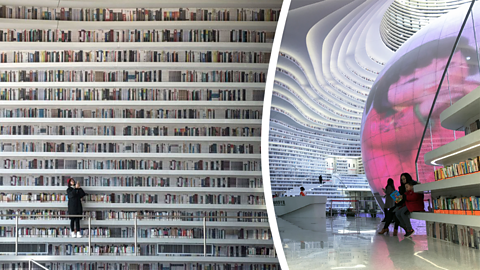
Tianjin Binhai Library, Tianjin, China
Opened in 2017, the sweeping curves of the Tianjin Binhai Library flow around a central glowing spherical auditorium. Take a step back and it looks a bit like an eyeball nestled in an eye socket, so it's been nicknamed 'The Eye'.
The floor-to-ceiling bookshelves have space for 1.2 million books, with the walkways along the lower levels doubling as seating areas. However, the library currently only holds around 200,000 books. Due to time constraints, the plan to make the upper rows of bookshelves accessible through rooms behind the rows was axed. To disguise the lack of books up there, aluminium plates representing books were installed instead.
In addition to all the books, or pictures of, there are meeting and reading rooms, computer areas and lounge spaces.
This article was published in September 2024
Five amazing ceilings from around the world
Amaze at the stunning artwork that can be found on ceilings worldwide, from stained glass to geometric tiles to informative paintings.

The most extreme libraries on Earth
If you weren't excited to read before, you will be if you go to any of these libraries.
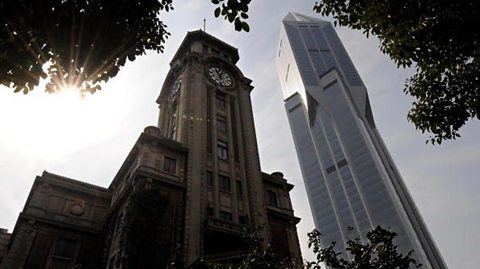
Four amazing canals from around the world
Discover four incredible but less well-known canals from across the world, and understand what makes them remarkable.

Looking for quizzes, amazing stories and fun facts?
Bitesize Topical has it all!
